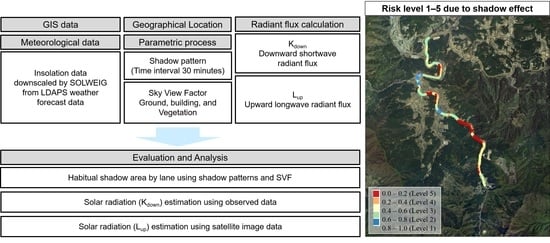Study on Radiative Flux of Road Resolution during Winter Based on Local Weather and Topography
Abstract
:1. Introduction
2. Materials and Methods
2.1. Study Area and Analysis Dates
2.2. LDAPS Weather Prediction Data
2.3. SOLWEIG Solar Radiation Model
2.4. GIS Data of Road Resolution
2.5. Observation for Radiation Verification
3. Results and Discussion
3.1. Shadow Pattern Analysis by Road Lane
3.2. Sky View Factor Analysis
3.3. Downward Shortwave Radiation Evaluation Using Observed Data
3.4. Upward Longwave Radiation Evaluation Using Satellite Imagery Data
4. Conclusions
Author Contributions
Funding
Conflicts of Interest
References
- Ibrahim, A.T.; Hall, F.L. Effect of Adverse Weather Conditions on Speed-Flow Occupancy Relationships; Transportation Research Board, Transportation Research Record 1457; National Research Council: Washington, DC, USA, 1994. [Google Scholar]
- Smith, B.L. An Investigation into the Impact of Rainfall on Freeway Traffic Flow; Transportation Research Board: Washington, DC, USA, 2004. [Google Scholar]
- FHWA. Empirical Studies on Traffic Flow in Inclement Weather (Publication No. FHWA-HOP-07-073). Federal Highway Administration (U.S. Department of Transportation). 2006. Available online: http://www.fhwa.dot.gov (accessed on 1 December 2020).
- Colyar, J.; Zhang, L.; Halkias, J. Identifying and Assessing Key Weather-Related Parameters and their Impact on Traffic Operations Using Simulation. In Proceedings of the ITE 2003 Annual Meeting, Seattle, WA, USA, 24–27 August 2003; Institute of Transportation Engineers: Washington, DC, USA, 2003. [Google Scholar]
- Sterzin, E.D. Modeling Influencing Factors in a Microscopic Traffic Simulator. Master’s Thesis, Department of Civil and Environmental Engineering, Massachusetts Institute of Technology, Cambridge, MA, USA, 2004. [Google Scholar]
- Lee, D.H.; Jeong, W.S.; Kim, H.J.; Kim, J.W. Study about the Evaluation of Freezing Risk Based Road Surface of Solar Radiation. J. Korea Inst. Struct. Maint. Insp. 2013, 17, 130–135. [Google Scholar] [CrossRef] [Green Version]
- Lee, K.K. Effects of Meteorological Factors on the Frequency of the Traffic Accidents in Seoul. J. Soc. Korea Ind. Syst. Eng. 2015, 38, 1–7. [Google Scholar] [CrossRef]
- Lee, S.J. A Study on Factors that Influence Traffic Accident Severity in Road Surface Freezing. J. Korean Soc. Saf. 2017, 32, 150–156. [Google Scholar]
- Lee, S.I.; Won, J.M.; Ha, O.K. A Study on the Development of a Traffic Accident Ratio Model in Foggy Areas. J. Korean Soc. Saf. 2008, 23, 171–177. [Google Scholar]
- Kim, B.J.; Nam, H.; Ha, T.R.; Kim, J.; Lee, Y.H. A Study on spatial and temporal variations in road weather elements and road surface temperature data observed in winter. J. Korean Data Anal. Soc. 2021, 23, 2419–2430. [Google Scholar] [CrossRef]
- Sass, B.H. A numerical model for prediction of road temperature and ice. J. Appl. Meteorol. Climatol. 1992, 31, 1499–1506. [Google Scholar] [CrossRef]
- Park, M.-S.; Joo, S.J.; Son, Y.T. Development of road surface temperature prediction model using the unified model output (UM-Road). Atmosphere 2014, 24, 471–479, (In Korean with English Abstract). [Google Scholar] [CrossRef] [Green Version]
- Bourgouin, P. A method to determine precipitation types. Weather Forecast. 2000, 15, 583–592. [Google Scholar] [CrossRef]
- Carriere, J.-M.; Lainard, C.; le Bot, C.; Robart, F. A climatological study of surface freezing precipitation in Europe. Meteorol. Appl. 2000, 7, 229–238. [Google Scholar] [CrossRef]
- Forbes, R.; Tsonevsky, I.; Hewson, T.; Leutbecher, M. Towards predicting high-impact freezing rain events. ECMWF Newsl. 2014, 141, 15–21. [Google Scholar] [CrossRef]
- Rozante, J.R.; Gutierrez, E.R.; da Silva Dias, P.L.; de Almeida Fernandes, A.; Alvim, D.S.; Silva, V.M. Development of an index for frost prediction: Technique and validation. Meteorol. Appl. 2020, 27, e1807. [Google Scholar] [CrossRef] [Green Version]
- Crevier, L.P.; Delage, Y. METro: A new model for road-condition forecasting in Canada. J. Appl. Meteorol. 2001, 40, 1226–1240. [Google Scholar] [CrossRef]
- Kangas, M.; Heikinheimo, M.; Hippi, M. RoadSurf: A modelling system for predicting road weather and road surface conditions. Meteorol. Appl. 2015, 22, 544–553. [Google Scholar] [CrossRef]
- Chao, J.; Zhang, J. Prediction model for asphalt pavement temperature in high-temperature season in Beijing. Adv. Civil. Eng. 2018, 2018, 1837952. [Google Scholar] [CrossRef] [Green Version]
- Korean Institute of Civil Engineering and Building Technology. Commercial Vehicle-Based Road and Traffic Information System; 1st Annual Report (No.18TLRP-B148886-01); Korean Institute of Civil Engineering and Building Technology: Goyang, Republic of Korea, 2018. [Google Scholar]
- Korean Institute of Civil Engineering and Building Technology. Commercial Vehicle-Based Road and Traffic Information System; 2nd Annual Report (No.19TLRP-B148886-02); Korean Institute of Civil Engineering and Building Technology: Goyang, Republic of Korea, 2019. [Google Scholar]
- Yang, C.H.; Kim, J.G. Developing Road Hazard Estimation Algorithms Based on Dynamic and Static Data. J. Korea Inst. Intell. Transp. Syst. 2020, 19, 55–66. [Google Scholar] [CrossRef]
- Lim, H.S.; Kim, S.T. A study on road ice prediction by applying road freezing evaluation model. J. Korean Appl. Sci. Technol. 2020, 37, 1507–1516. [Google Scholar] [CrossRef]
- Kang, M.-S.; Lim, H.-S.; Kwak, A.-M.-R.; Lee, G. A study on road ice prediction algorithm model and road ice prediction rate using algorithm model. J. Korean Appl. Sci. Technol. 2021, 38, 1355–1369. [Google Scholar] [CrossRef]
- Park, M.S.; Kang, M.; Kim, S.H.; Jung, H.C.; Jang, S.B.; You, D.G.; Ryu, S.H. Estimation of road sections vulnerable to black ice using road surface temperatures obtained by a mobile road weather observation vehicle. Atmosphere 2021, 31, 525–537. [Google Scholar]
- Korea Transport Institute. Discovering and Preventing Black Ice Using AI and Big Data; Korea Transport Institute: Sejong City, Republic of Korea, 2021. [Google Scholar]
- Rayer, P.J. The meteorological office forecast road surface temperature model. Meteorol. Mag. 1987, 116, 180–191. [Google Scholar]
- Kim, D.; Yoon, S.; Kim, B. Comparison of spatial interpolation methods for producing road weather information in winter. J. Korean Data Anal. Soc. 2020, 23, 541–551. [Google Scholar] [CrossRef]
- Stehman, S.V. Selecting and interpreting measures of thematic classification accuracy. Remote Sens. Environ. 1997, 62, 77–89. [Google Scholar] [CrossRef]
- Korea Meteorological Administration. Numerical Forecasting Is Responsible for Meteorological and Climate Industries; Korea Meteorological Administration: Seoul, Republic of Korea, 2013; p. 17. [Google Scholar]
- Lindberg, F.; Holmer, B.; Thorsson, S. SOLWEIG 1.0—Modelling spatial variations of 3D radiant fluxes and mean radiant temperature in complex urban settings. Int. J. Biometeorol. 2008, 52, 697–713. [Google Scholar] [CrossRef] [PubMed]
- Lindberg, F.; Grimmond, C. The influence of vegetation and building morphology on shadow patterns and mean radiant temperature in urban areas: Model development and evaluation. Theor. Appl. Climatol. 2011, 105, 311–323. [Google Scholar] [CrossRef]
- Lindberg, F.; Onomura, S.; Grimmond, C.S.B. Influence of ground surface characteristics on the mean radiant temperature in urban areas. Int. J. Biometeorol. 2016, 60, 1439–1452. [Google Scholar] [CrossRef] [PubMed]
- Yi, C.; Kwon, H.G.; Lindberg, F. Radiation flux impact in high density residential areas. J. Korea Assoc. Geogr. Inf. Stud. 2018, 21, 40–46. [Google Scholar] [CrossRef]
- Yang, H.J.; Yi, C.Y.; Bae, M.K. The analysis of road surface characteristics for road risk management in heat wave: Focused on Cheongju City. J. Environ. Policy Adm. 2019, 27, 51–73. [Google Scholar] [CrossRef]
- Hsu, C.Y.; Ng, U.C.; Chen, C.Y.; Chen, Y.C.; Chen, M.J.; Chen, N.T.; Lung, S.C.C.; Su, H.J.; Wu, C.D. New land use regression model to estimate atmospheric temperature and heat island intensity in Taiwan. Theor. Appl. Climatol. 2020, 141, 1451–1459. [Google Scholar] [CrossRef]
- National Spatial Data Infrastructure Portal. Available online: http://data.nsdi.go.kr (accessed on 1 October 2020).
- Environmental Geographic Information Service, Korean Ministry of Environment. Available online: https://egis.me.go.kr (accessed on 10 October 2020).
- Guan, K.K. Surface and Ambient Air Temperatures Associated with Different Ground Material: A Case Study at the University of California, Berkeley. Surf. Air Temp. Ground Mater. 2011, 196, 1–14. [Google Scholar]
- Bogren, J. Screening effects on road surface temperature and road slipperiness. Theor. Appl. Climatol. 1991, 43, 91–99. [Google Scholar] [CrossRef]
- Kim, Y.J.; Kim, B.J.; Shin, Y.S.; Kim, H.W.; Kim, G.T.; Kim, S.J. A case study of environmental characteristics on urban road-surface and air temperatures during heat-wave days in Seoul. Atmos. Ocean. Sci. Lett. 2019, 12, 261–296. [Google Scholar] [CrossRef] [Green Version]
- Karsisto, V.; Nurm, P. Using car observations in road weather forecasting. In Proceedings of the 18th International Road Weather Conference, Fort Collins, CO, USA, 27–29 April 2016. [Google Scholar]
- Tegegne, E.B.; Ma, Y.; Chen, X.; Ma, W.; Wang, B.; Ding, Z.; Zhu, Z. Estimation of the distribution of the total net radiative flux from satellite and automatic weather station data in the Upper Blue Nile basin, Ethiopia. Theor. Appl. Climatol. 2021, 143, 587–602. [Google Scholar] [CrossRef]
- Bell, M.; Ellis, H. Sensitivity analysis of tropospheric ozone to modified biogenic emissions for the Mid-Atlantic region. Atmos. Environ. 2004, 38, 1879–1889. [Google Scholar] [CrossRef]
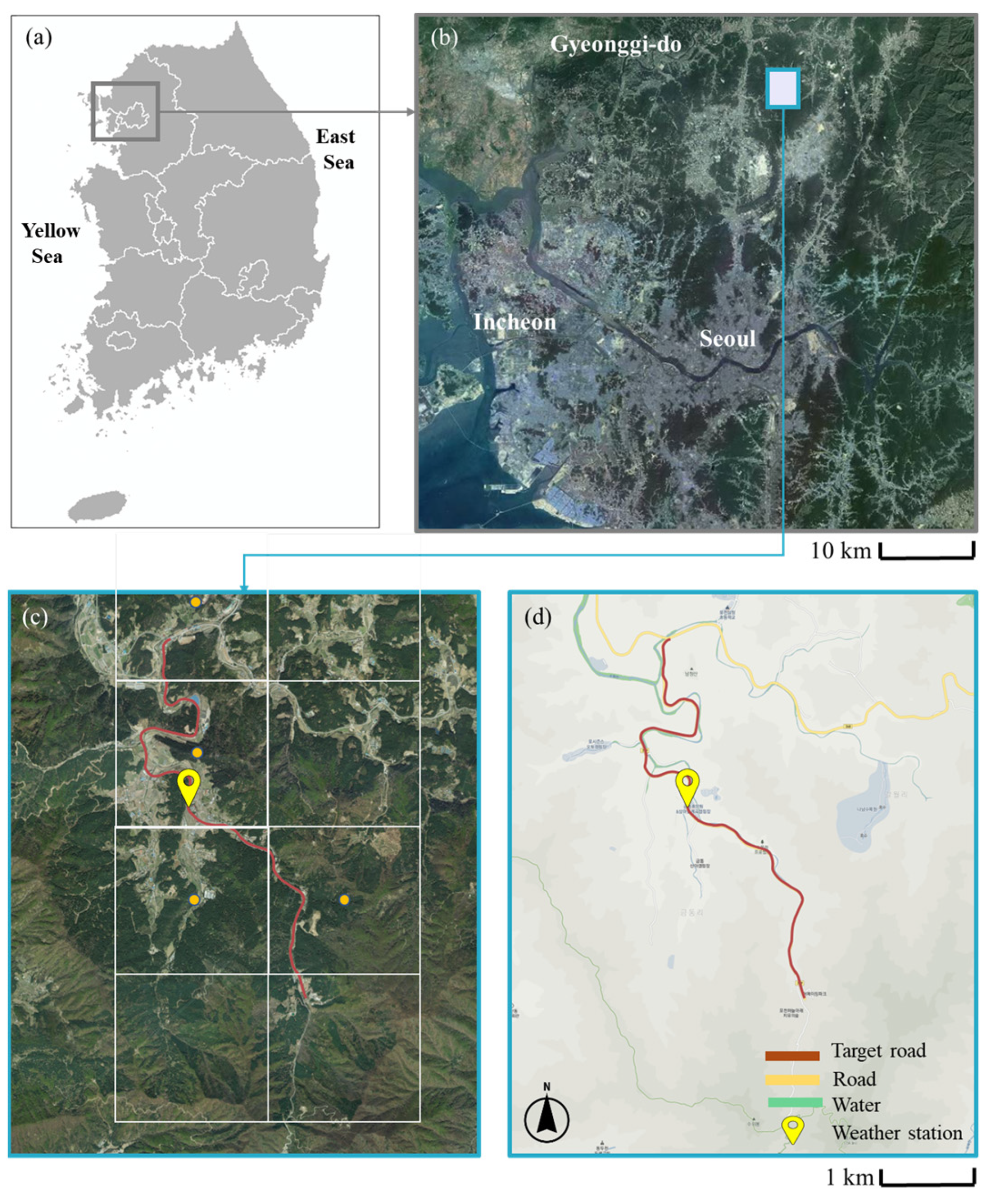

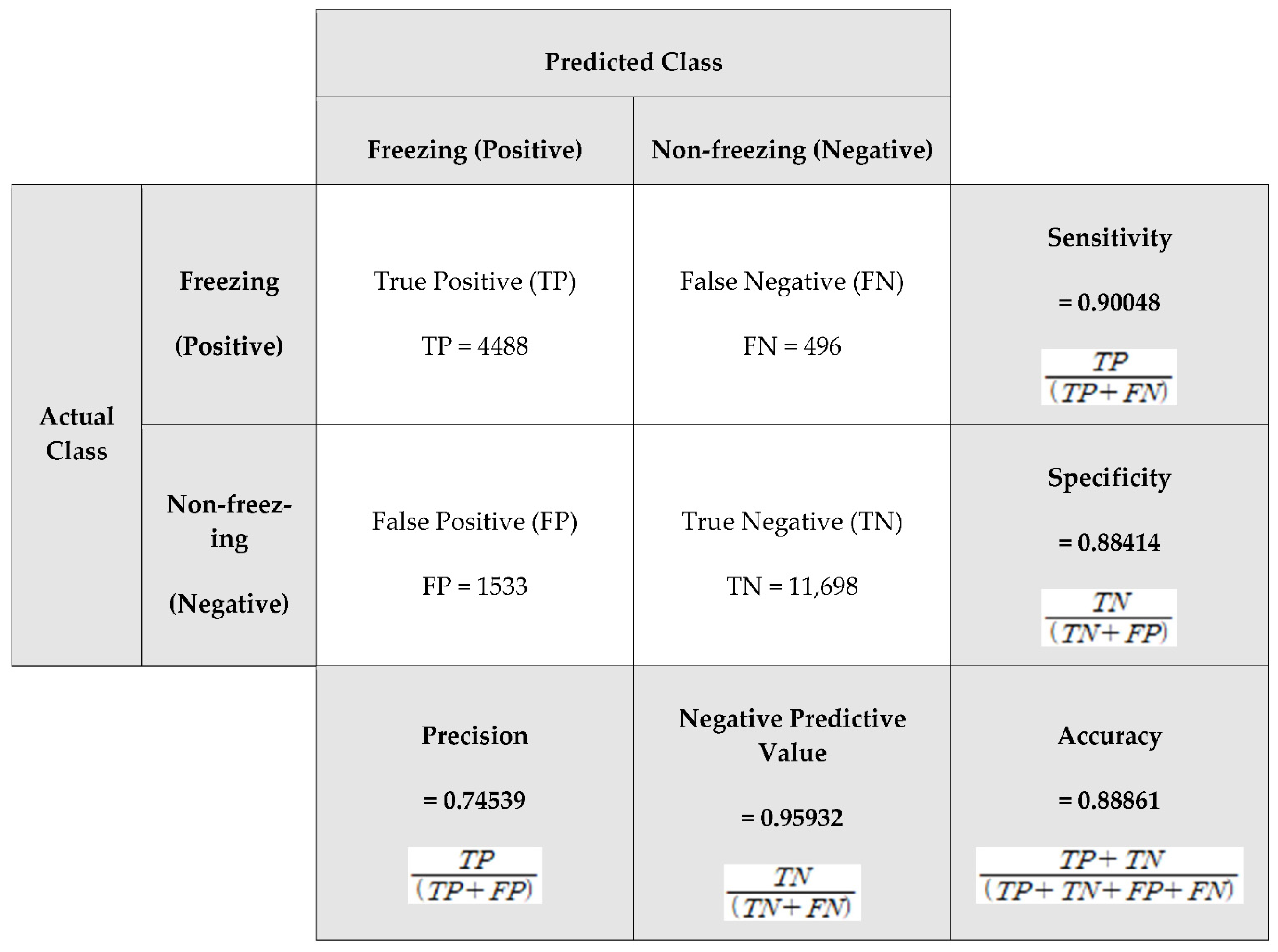
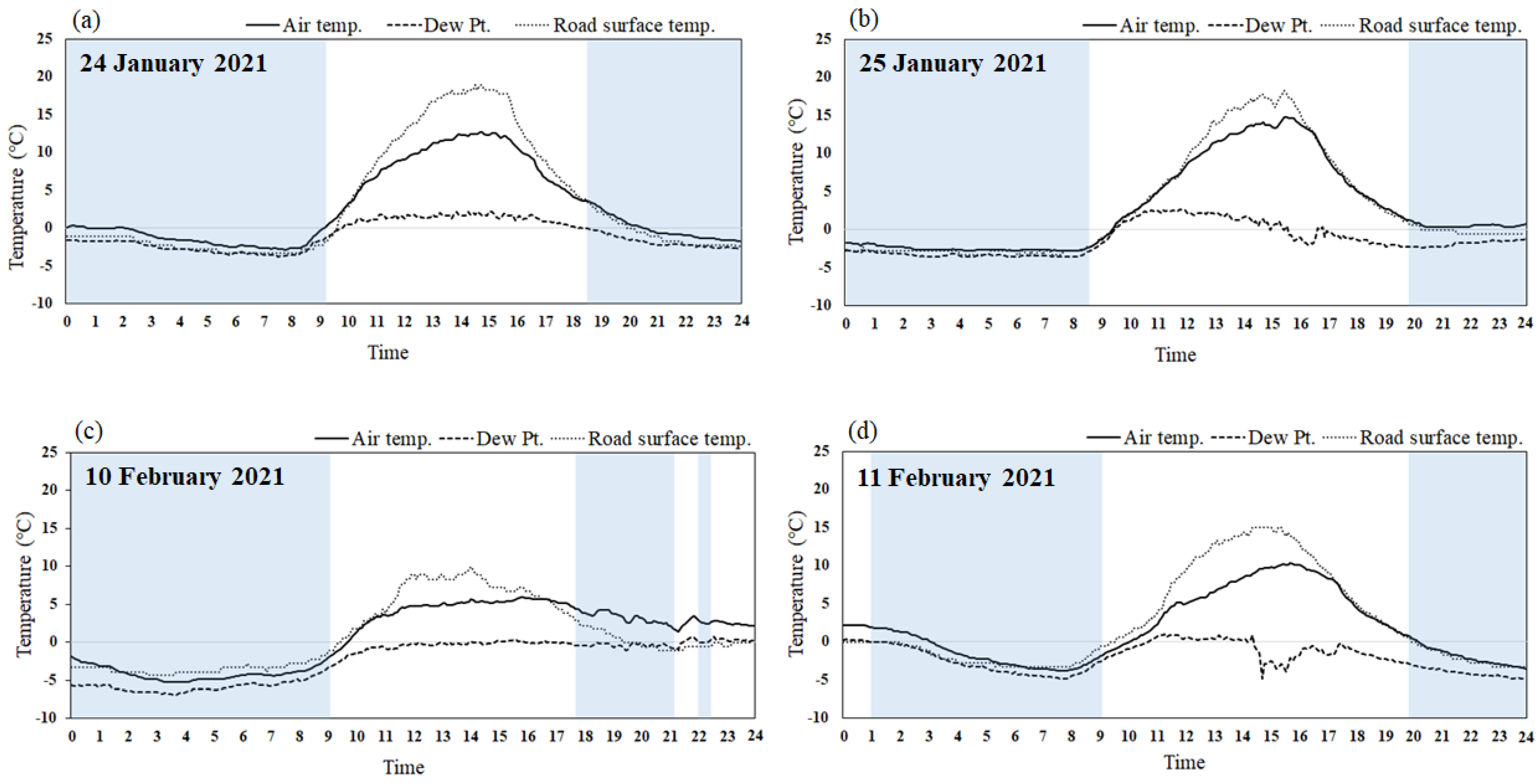

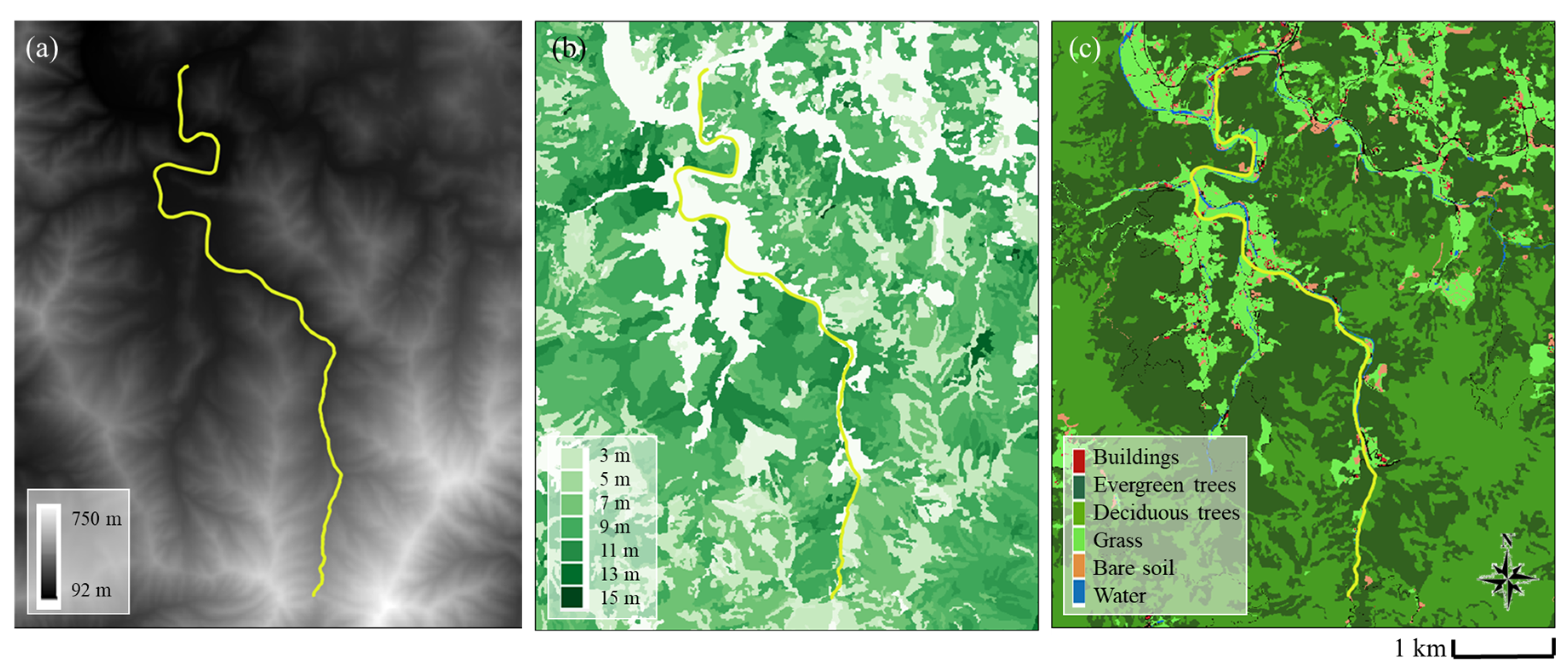
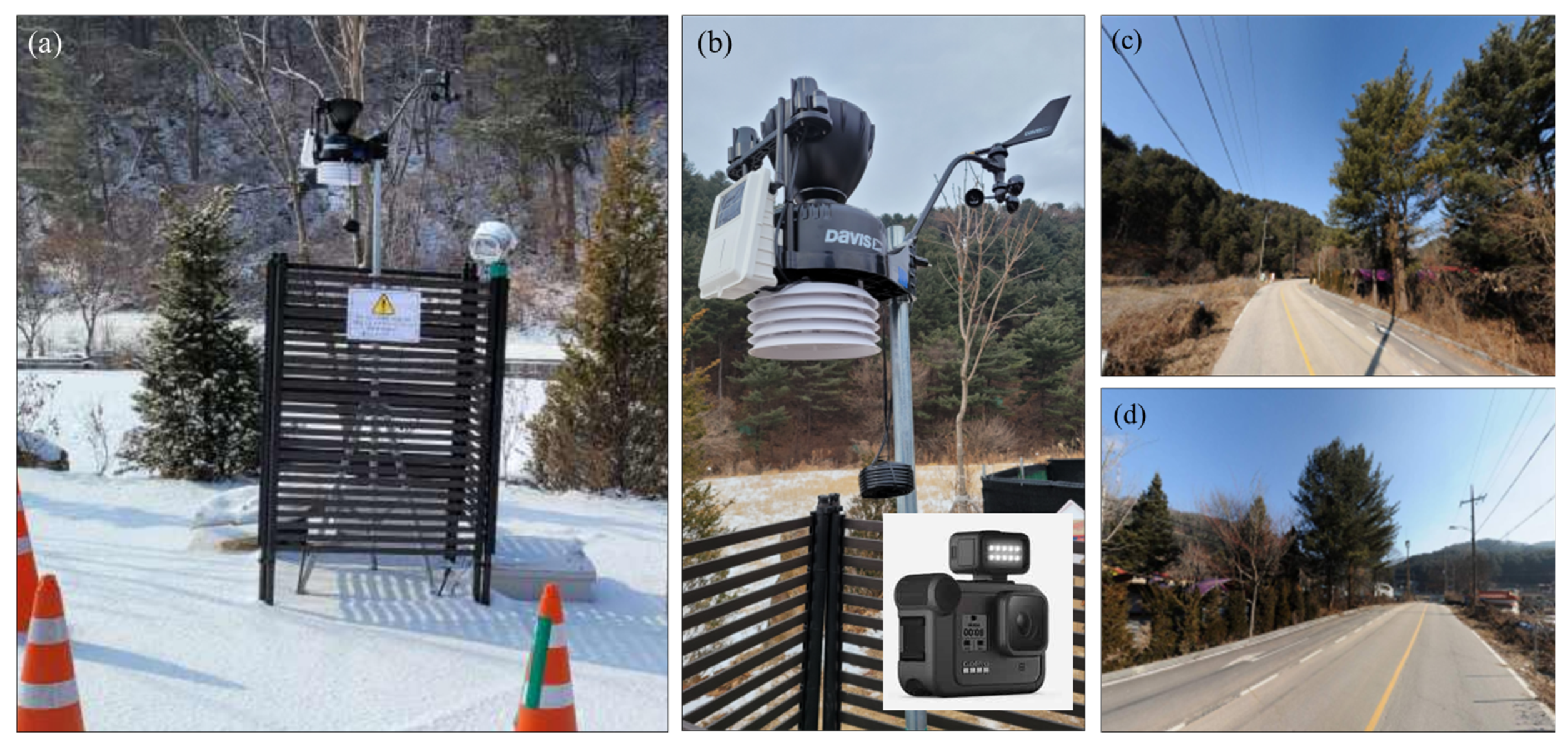
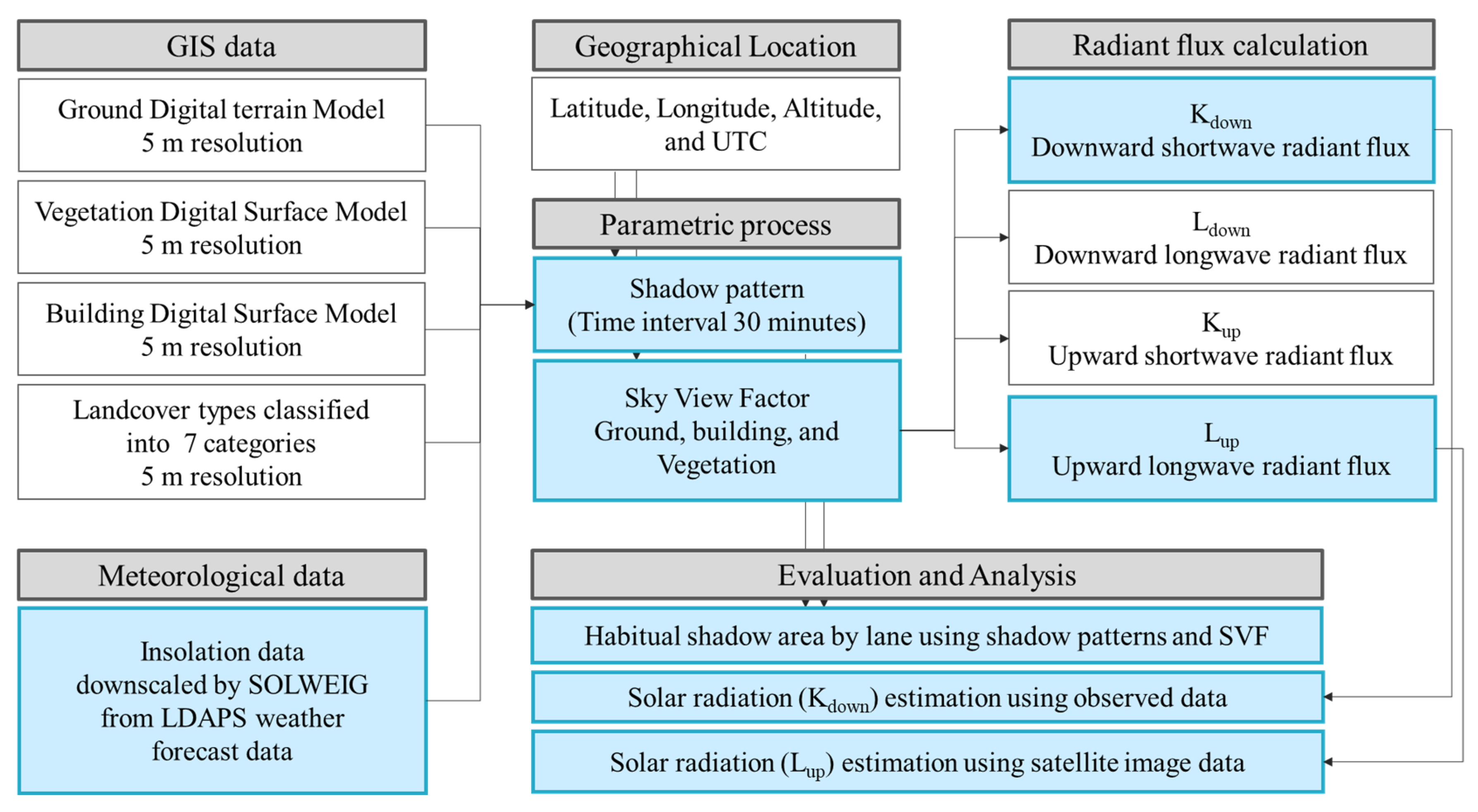
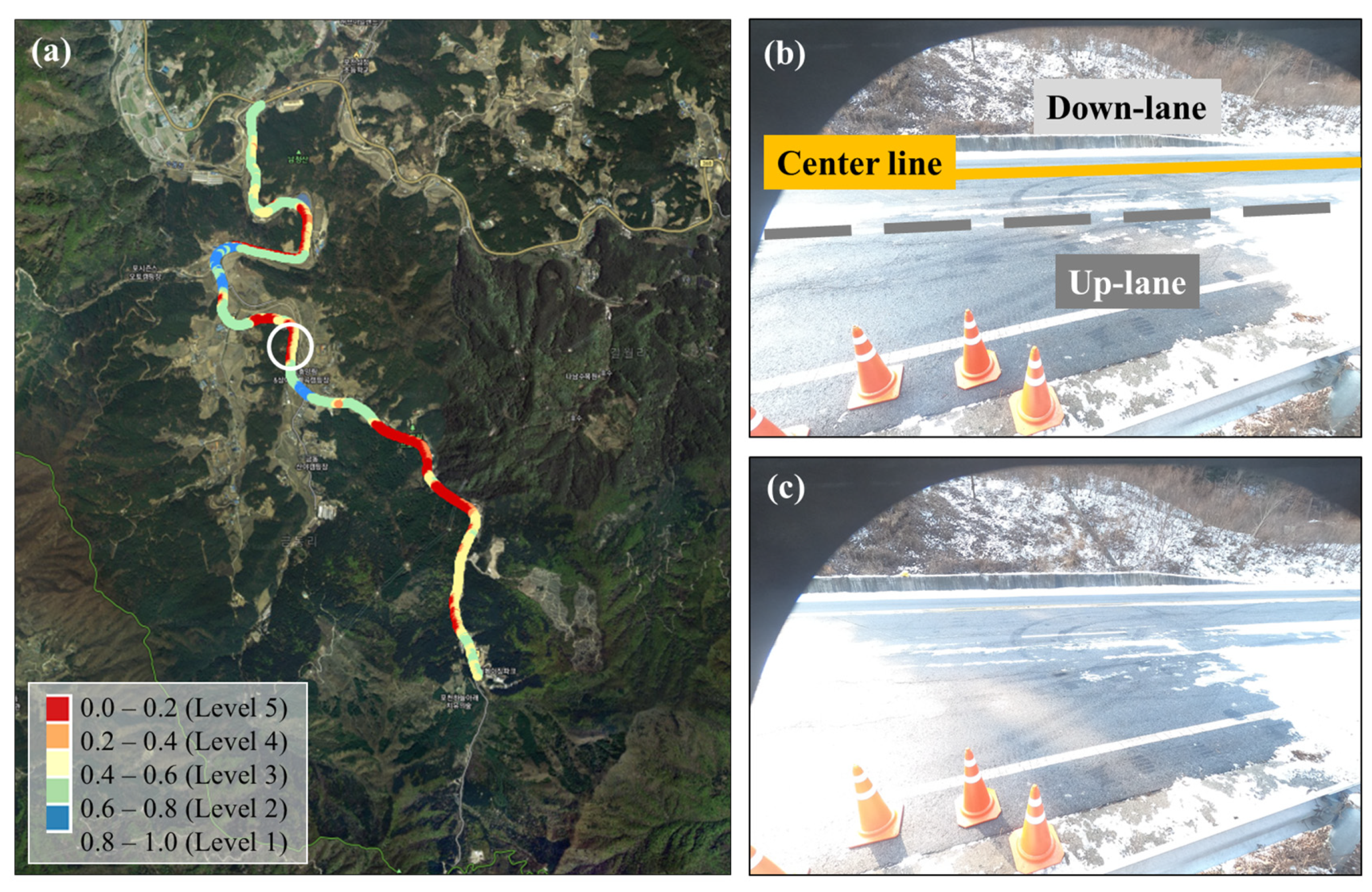
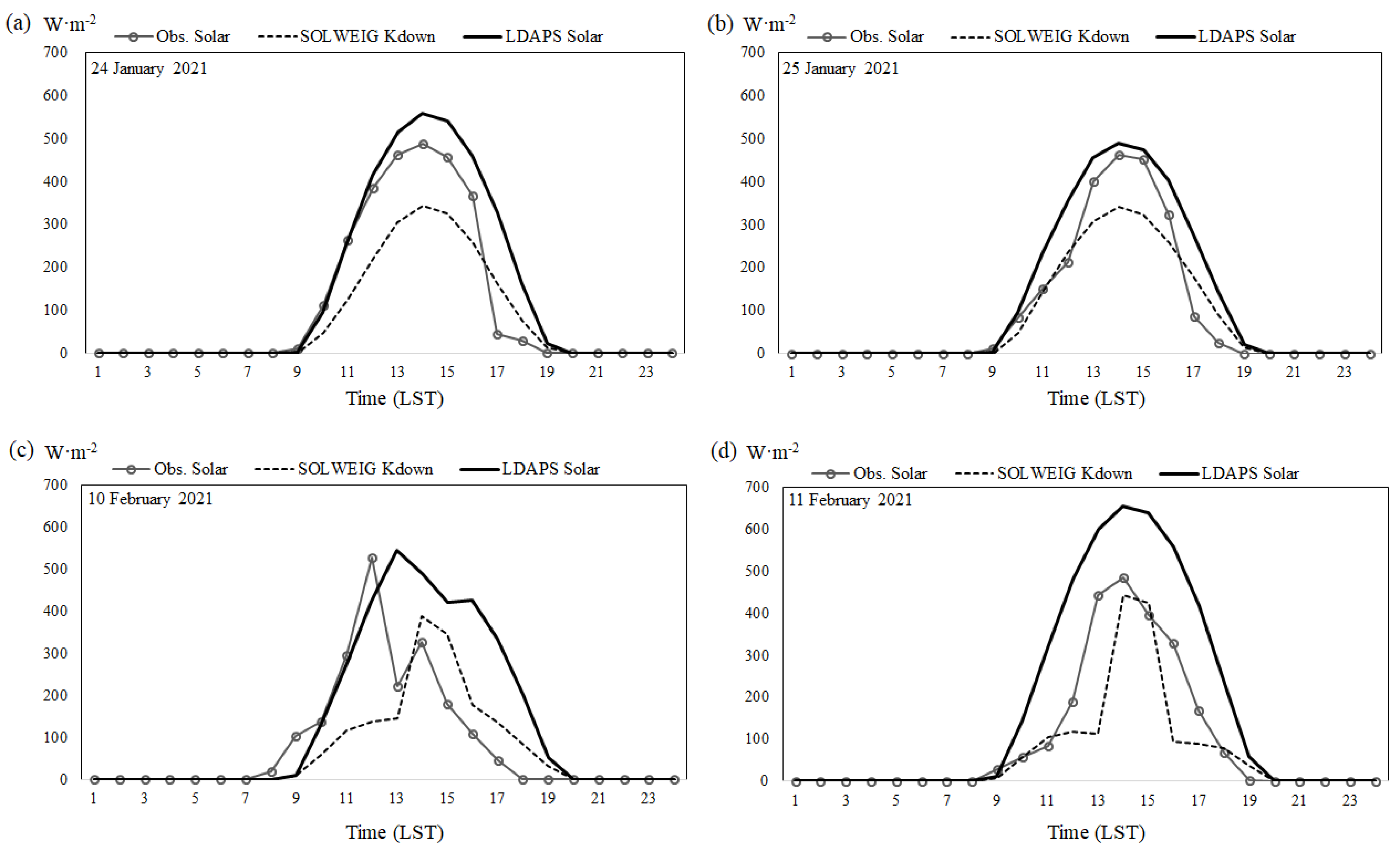



| Name | Code | Albedo (α) | Emissivity (ε) | Ts/η max (°C) | Tstart (◦C) | TmaxLST (Local Time, h) |
|---|---|---|---|---|---|---|
| Cobble_stone_2014a | 0 | 0.20 | 0.95 | 0.37 | −3.41 | 15.00 |
| Dark_asphalt | 1 | 0.18 | 0.95 | 0.58 | −9.78 | 15.00 |
| Roofs (buildings) | 2 | 0.18 | 0.95 | 0.58 | −9.78 | 15.00 |
| Evergreen | 3 | 0.16 | 0.94 | 0.21 | −3.38 | 14.00 |
| Deciduous | 4 | 0.16 | 0.94 | 0.21 | −3.38 | 14.00 |
| Grass_unmanaged | 5 | 0.16 | 0.94 | 0.21 | −3.38 | 14.00 |
| Bare_soil | 6 | 0.25 | 0.94 | 0.33 | −3.01 | 14.00 |
| Water | 7 | 0.05 | 0.98 | 0 | 0 | 12.00 |
| Observation | Resolution | Range | Error Range |
|---|---|---|---|
| Wind direction | 1° | 0~360° | ±3° |
| Wind speed | 0.1 m/s | 0~67 m/s | ±5% |
| Temperature | 0.1 °C | −40~65 °C | ±0.5 °C |
| Relative humidity | 1% | 0~100% | ±3% |
| Dew point | 0.1 °C | −76~54 °C | ±1.5 °C |
| Precipitation | 0.2 mm | 0~6553 mm | ±4% |
| Pressure (Altitude range—600~4750 m) | 0.1 mmHg 0.1 mb | 410~820 mm Hg540~1100 mb (hPa) | ±0.8 mmHg ± 1.0 mb (hPa) |
| Solar radiation | 1 w/m2 | 0~1800 w/m2 | ±5% |
| Surface temperature | 1 °C | −40~65 °C | ±0.5 °C |
| Surface condition | 12 MP, Day and nighttime lapse | ||
| Shadow Pattern | Up-Line | Down-Line | |||||
|---|---|---|---|---|---|---|---|
| Up-Line | Down-Line | Average | Level 1 (%) | Level 5 (%) | Level 1 (%) | Level 5 (%) | |
| 8:00 | 0.000 | 0.000 | 0.000 | 0.00 | 0.00 | 0.00 | 0.00 |
| 8:30 | 0.044 | 0.042 | 0.043 | 4.35 | 95.65 | 4.15 | 95.85 |
| 9:00 | 0.296 | 0.239 | 0.269 | 29.35 | 70.65 | 23.37 | 76.63 |
| 9:30 | 0.552 | 0.398 | 0.471 | 54.68 | 45.32 | 38.64 | 61.36 |
| 10:00 | 0.814 | 0.596 | 0.697 | 80.94 | 19.06 | 58.53 | 41.47 |
| 10:30 | 0.846 | 0.614 | 0.721 | 84.17 | 15.83 | 60.37 | 39.63 |
| 11:00 | 0.855 | 0.616 | 0.724 | 85.03 | 14.97 | 60.50 | 39.50 |
| 11:30 | 0.860 | 0.613 | 0.727 | 85.55 | 14.45 | 60.24 | 39.76 |
| 12:00 | 0.837 | 0.600 | 0.711 | 83.25 | 16.75 | 58.92 | 41.08 |
| 12:30 | 0.827 | 0.598 | 0.703 | 82.19 | 17.81 | 58.72 | 41.28 |
| 13:00 | 0.823 | 0.598 | 0.701 | 81.73 | 18.27 | 58.66 | 41.34 |
| 13:30 | 0.789 | 0.581 | 0.667 | 78.23 | 21.77 | 56.95 | 43.05 |
| 14:00 | 0.731 | 0.550 | 0.628 | 72.23 | 27.77 | 53.79 | 46.21 |
| 14:30 | 0.675 | 0.509 | 0.586 | 66.69 | 33.31 | 49.97 | 50.03 |
| 15:00 | 0.590 | 0.432 | 0.501 | 58.05 | 41.95 | 42.13 | 57.87 |
| 15:30 | 0.504 | 0.369 | 0.427 | 49.74 | 50.26 | 36.08 | 63.92 |
| 16:00 | 0.339 | 0.282 | 0.305 | 33.58 | 66.42 | 27.72 | 72.28 |
| 16:30 | 0.130 | 0.124 | 0.125 | 12.73 | 87.27 | 11.98 | 88.02 |
| 17:00 | 0.000 | 0.000 | 0.000 | 0.00 | 0.00 | 0.00 | 0.00 |
| 17:30 | 0.000 | 0.000 | 0.000 | 0.00 | 0.00 | 0.00 | 0.00 |
| Shadow Pattern Level | Lane | 1 | 2 | 3 | 4 | 5 |
|---|---|---|---|---|---|---|
| Shadow pattern value | Up | 0.800 | 0.671 | 0.486 | 0.286 | 0.078 |
| Down | 0.802 | 0.672 | 0.483 | 0.274 | 0.037 | |
| SVFbuilding-ground | Up | 0.937 | 0.943 | 0.928 | 0.927 | 0.927 |
| Down | 0.945 | 0.955 | 0.924 | 0.917 | 0.909 | |
| SVFvegetation | Up | 0.968 | 0.935 | 0.883 | 0.879 | 0.832 |
| Down | 0.978 | 0.965 | 0.857 | 0.590 | 0.403 |
Publisher’s Note: MDPI stays neutral with regard to jurisdictional claims in published maps and institutional affiliations. |
© 2022 by the authors. Licensee MDPI, Basel, Switzerland. This article is an open access article distributed under the terms and conditions of the Creative Commons Attribution (CC BY) license (https://creativecommons.org/licenses/by/4.0/).
Share and Cite
Kwon, H.-G.; Yang, H.; Yi, C. Study on Radiative Flux of Road Resolution during Winter Based on Local Weather and Topography. Remote Sens. 2022, 14, 6379. https://doi.org/10.3390/rs14246379
Kwon H-G, Yang H, Yi C. Study on Radiative Flux of Road Resolution during Winter Based on Local Weather and Topography. Remote Sensing. 2022; 14(24):6379. https://doi.org/10.3390/rs14246379
Chicago/Turabian StyleKwon, Hyuk-Gi, Hojin Yang, and Chaeyeon Yi. 2022. "Study on Radiative Flux of Road Resolution during Winter Based on Local Weather and Topography" Remote Sensing 14, no. 24: 6379. https://doi.org/10.3390/rs14246379





